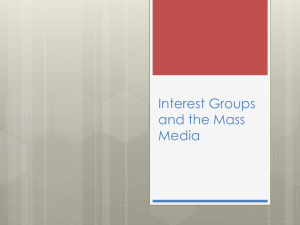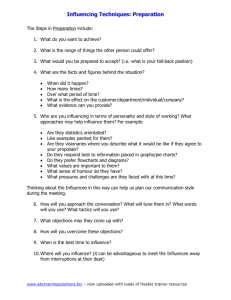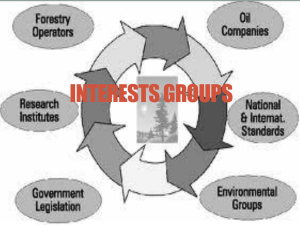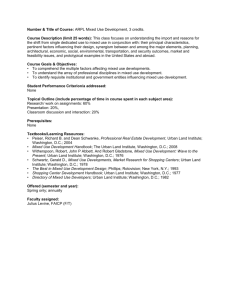Lecture12
advertisement
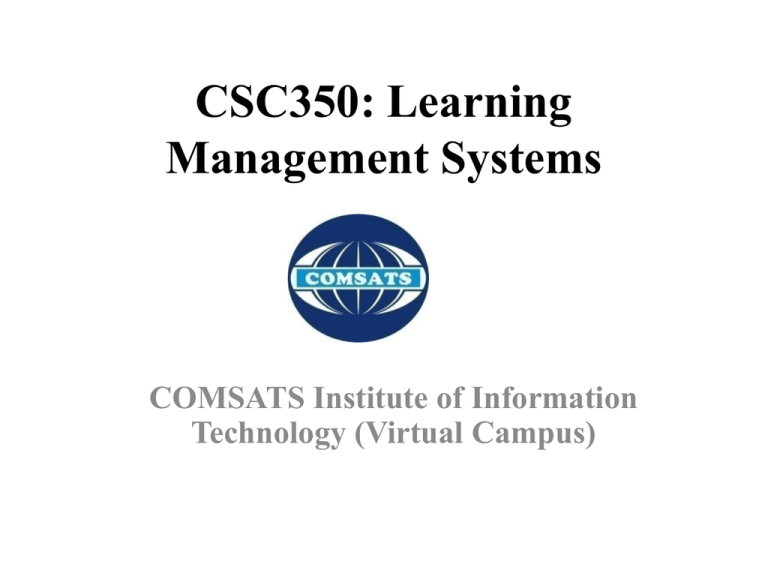
CSC350: Learning Management Systems COMSATS Institute of Information Technology (Virtual Campus) Lecture # 12 Influencing and Communication 2 Review of the Previous Lecture 1. Fundamental principles of changing an organization 2. Insights about factors to consider when changing an organization 3. An appreciation for the relationship between change and stress 4. How to handle conflict as a factor related to organizational change 5. Knowledge about virtuality as a vehicle for organizational change 3 Topics of Discussion 1. A fundamental understanding of influencing 2. Insights about emotional intelligence 3. An understanding of how communication works 4. Hints for communicating in organizations 5. Useful ideas for encouraging organizational communication 4 FUNDAMENTALS OF INFLUENCING • Process of guiding activities of organization members in appropriate directions • Focusing on organization members as people • Ability to influence others is a primary determinant of a successful manager 5 Influencing Subsystem 6 Constituent Parts of Influencing Subsystem 7 Skills Management Students Need 8 EMOTIONAL INTELLIGENCE • Daniel Goleman • Capacity of people to recognize their own feelings and the feelings of others, to motivate themselves, and to manage their own emotions as well as their emotions in relationships with others 9 Skills of Emotionally Intelligent Managers 10 Influencing & Emotionally Intelligent Management Concepts • • • • • • Motivation Communication Leadership Teamwork Creativity Innovation 11 COMMUNICATION • Process of sharing information with individuals • One person projecting a message to one or more other people with hopefully all parties involved arriving at a common understanding of the message that was sent 12 Interpersonal Communication • Three basic elements: – Source/Encoder – Signal – Decoder/Destination Source determines information to share, Encodes that message, Transmits message to Destination, Destination decodes the message 13 Communication Process 14 Getting to Understanding 15 Communication Barriers • Macro Barriers – Increasing need for complex information – Increasing number of languages needed – Decreased time available for communication • Micro Barriers – – – – Message interference Destination’s view of the source Perception Multimeaning words 16 Verbal & Nonverbal Communication • Verbal – Spoken or written words used to share information with others • Nonverbal – Sharing information without using words to encode thoughts – Gestures, vocal tones, facial expressions 17 Mehrabian Formula • Total Message Impact = 100% – Words/Message = 7% – Vocal Tones = 38% – Facial Expressions = 55% Effective managers use verbal communication in support of nonverbal communication 18 INTERPERSONAL COMMUNICATION IN ORGANIZATIONS • Organizational Communication – Directly related to goals, functions, and structure of organizations – Directly connected to the effectiveness of organizations 19 Formal Organizational Communication • Follows lines of firm’s organizational chart • Downward – Focus is on communication related to direction and control • Upward – Focus is on communication managers need to evaluate their organizational area • Lateral – Focus is on coordinating activities of various departments 20 Informal Organizational Communication • Follows pattern of personal relationships among organization members • Grapevine – Single-Strand – Gossip – Probability – Cluster 21 Grapevines Estimated 70% of all organizational communications flow through the grapevine 22 Encouraging Organizational Communication • The nervous system of the organization • Directs the organization to act • Management should encourage free flow of communication • Make sure leaders sending messages are trusted by their employees • Listen attentively! 23 Guidelines for Effective Listening 24 Thank You 25
